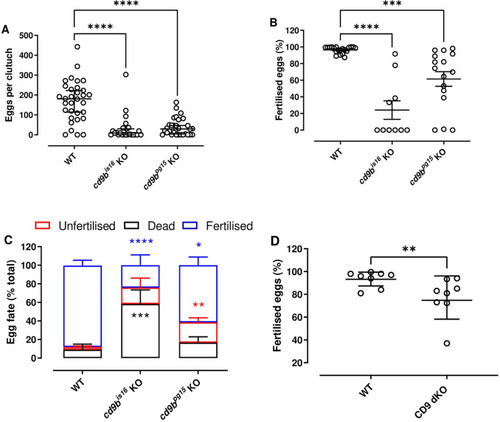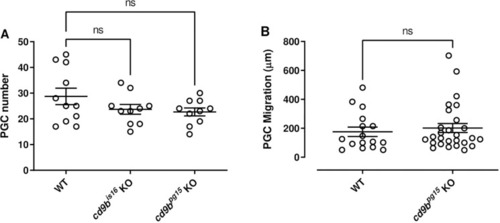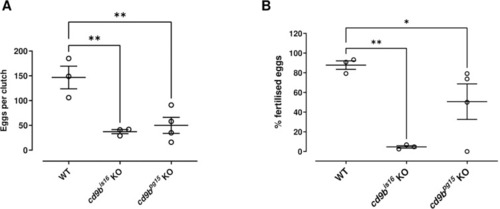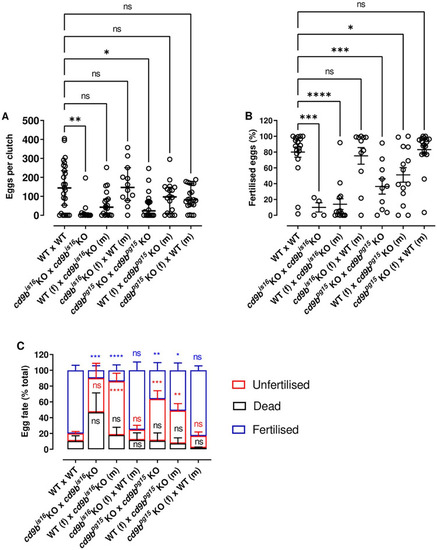- Title
-
Tetraspanin Cd9b plays a role in fertility in zebrafish
- Authors
- Greaves, S., Marsay, K.S., Monk, P.N., Roehl, H., Partridge, L.J.
- Source
- Full text @ PLoS One
|
cd9b mutant pairs lay smaller clutches of eggs with significantly fewer fertilised eggs. A significant decrease in the total number of eggs laid per pair, including fertilised, dead and unfertilised eggs, is seen with cd9b mutant pairs (A). The percentage of fertilised eggs is significantly decreased in clutches from cd9b mutant pairs (B). Given the significant decrease in fertilised eggs seen in (B), it can be inferred that there is a significant increase in the percentage of dead and unfertilised eggs per clutch from cd9b mutants. This increase is apparent in (C), where the average breakdown of clutches from WT and cd9b mutant pairs is shown. The additional loss of cd9a in cd9 dKOs did not result in a further decrease in the fertilisation rate (D). Data from 5 experimental repeats carried out over several weeks. (A), (B) and (C) represent pooled data from 5 experimental repeats. A Kruskal-Wallis test with Dunn?s multiple comparisons test where p<0.05 was performed on (A). An ANOVA with Dunnett?s multiple comparisons test was performed on (B, C) after removal of definitive outliers (3 outliers, ROUT, q = 0.1) to give normally distributed data (p<0.05). n = minimum 25 pairs (A), minimum 10 pairs (B, C) per genotype. Only pairs that laid eggs were counted in (B) and (C), whereas all pairs were counted in (A). (D) represents 8 separate matings, with a Mann-Whitney U test of significance. Significance of difference from WT control: **** p<0.001; *** p<0.005; ** p<0.01; * p<0.05; ns = not significant. |
|
cd9b homozygous mutants have the same number of PGC per embryo at 32 hpf and migration to the gonadal ridge is not affected in cd9bpg15 mutants at 30 hpf. (A) There is no significant difference in the number of PGCs in WT and cd9b mutant embryos at 32 hpf. PGCs were visualised using a vasa ISH on 32 hpf embryos and analysed using an ANOVA with Dunnett?s multiple comparisons test on n = minimum 10 embryos per genotype. (B) vasa ISH on 30 hpf WT and cd9bpg15 embryos. PGC migration efficiency was analysed by looking at the distance between the most anterior and posterior PGC, which should have reached the gonadal ridge by 30 hpf. No significant difference was seen between WT and cd9b mutants as shown by a Mann-Whitney U test. n = at least 13 individual embryos. Data from a single experiment. |
|
Clutches from cd9b mutant pairs, produced by IVF, have a decreased clutch size and lower percentage of eggs fertilised per clutch. The number of eggs is significantly decreased in clutches from cd9b mutant pairs (A). Of the eggs laid, a significantly lower percentage were fertilised by cd9b mutant males (B). Dead eggs were immediately discarded during the IVF protocol and therefore (A) and (B) represent only fertilised and unfertilised eggs. n = minimum 3 pairs per genotype. ANOVA with Holm-Sidak multiple comparisons test was carried out on the original data from (A) and on arcsine transformed data in (B). The Holm-Sidak post-hoc test was chosen as it has more power than Dunnett?s multiple comparisons test. Significance of difference from WT control: ** p<0.01; * p<0.05; ns = not significant. Data from a single experiment. |
|
Clutch size can be rescued by substitution of either cd9b mutant partner for an WT, however, fertilisation is only rescued when the cd9b KO male is substituted for an WT male. Clutch size can be rescued by substitution of a cd9b mutant partner, male (m) or female (f), with an WT (A). A Kruskal-Wallis test with Dunn?s multiple comparisons test was carried out on the pooled data from three experimental repeats. n = minimum 12 pairs per cross. While clutch size can be partially or fully rescued by substitution of either cd9b mutant partner, the percentage of fertilised eggs appears to only return to WT levels upon substitution of a cd9b mutant male with an WT male (B). An ANOVA with Dunnett?s multiple comparisons test was carried out on arcsine transformed data pooled from three experiments. The average percentage of fertilised, dead and unfertilised eggs per clutch is shown in (C). n = minimum 10 pairs per cross for (B) and (C), except cd9bis16 x cd9bis16 where only 4 of 12 pairs laid. Significance of difference from WT control: **** p<0.001; *** p<0.005; ** p<0.01; * p<0.05; ns = not significant. Data was pooled from 3 experimental repeats carried out over several weeks. |




